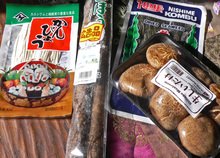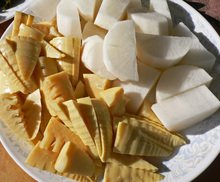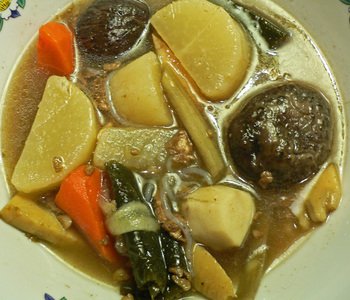*** I have an updated (2014) version of this recipe here if you're interested.
Nishime; a humble Japanese Vegetable Stew, is a New Years staple for many households in Hawaii. There are probably as many different Nishime recipes as there are Families, and you are sure to find Nishime at almost any New Years "spread" in Hawaii.
Actually, I've been trying to retire from making Nishime for several years. As soon as New Year approaches, I'd ask the Missus if she wants me to make "Sukiyaki". And Her answer will always be the same; "No, I want Nishime". "Why?" "Because it takes much more time and labor to make. And that is a labor of love. heeheehee." It's quite surprising that such a humble stew, takes so much time and effort to make. Though to be honest, many of the ingredients can be bought already cut, sliced, or otherwise prepared. But for some reason the Nishime made with pre-made ingredients doesn't taste the same. It probably lacks the saltiness from the sweat of my labor! The actual cooking time is only about 30 minutes or so. It's the preparation that takes time.
Please forgive the somewhat "disjointed" recipe. I've tried to present the process in a fairly coherent manner, including many steps that are probably obvious to anyone who has made Nishime, or any similar dish before.
1 Lb Thinly sliced lean pork(We use Beef, the Missus enjoys the flavor)
2 Tb Vegetable Oil
5 Cups Water
2 36" Strips Nishime(not Dashi) Kombu(Kelp)
1 Strip Kanpyo (Dried Gourd)
2 Packages Konnyaku or Shirataki
2 Cups Daikon cut into wedges
1 Cup Carrots cut using a rolling cut
2 Cans Takenoko Tips(Bamboo Shoot Tips)
2 Stalks Gobo (Burdock Root)
12-15 Satoimo/Araimo/Dasheen(Japanese Taro)
6 dried or fresh Shiitake Mushroom – rehydrated in warm water if dried
1/2 Cup Soy Sauce
1/4 Cup Sugar
1/4 Cup Mirin
2 Tb Sake
1/2 Tsp salt
2 Cloves Garlic Minced
1 – Place two large pots of water on the stove and bring to a boil.
2 – Wash Kombu, and strip lengthwise if wider then 3 inches. Tie into knots at 2 inch intervals. To make the Kombu the way I do it, tie one strip of Kombu into knots, and leave the other as is. Soak Kombu in water for 20 minutes. Soak Kanpyo in water for 20 minutes.
3 – Cut Gobo in half; and scrape "skin/bark" off of root using a spoon. Immediately place in water to prevent discoloration. Cut Gobo into 1/2" matchstick lengths. Parboil in water for several minutes(I use a microwave for 3 minutes on high)
4 – Blanch and peel Araimo, and place in water to avoid discoloration.(Blanching makes the taro much easier to peel) Be careful if cutting the taro, it is very starchy and slippery.
5 – Because the Missus likes her Kombu in "maki"(roll) form; I'll tie half the Kombu, and make the other half into maki as a compromise; rolling the Kombu and tying with a short strip of Kanpyo.
 6 – If the smell or slight bitterness of Bamboo Shoots bothers you, pour boiling water over Bamboo Shoots, drain, then cut into slices lengthwise.
6 – If the smell or slight bitterness of Bamboo Shoots bothers you, pour boiling water over Bamboo Shoots, drain, then cut into slices lengthwise.
7 – If using Shirataki(yam noodles), open packages and place in a colander. Pour boiling water over Shirataki to remove the "smell". If using Konnyaku, slice crosswise.
8 – Cut Daikon into "wedges", cut Carrots using a "rolling cut".
9 – Mince garlic.
10 – Heat oil over medium heat. Add garlic and pork until light brown in color.
11 – Add water, all the vegetables(except Shiitakes), sugar, sake, and mirin. Bring to a slow boil  and cook for 15 minutes.
and cook for 15 minutes.
12 – Add Shiitakes, soy sauce, and salt and simmer 15 minutes, or until cooked. Taste and make adjustments to flavoring.
Like most stews, the Nishime will taste better the day after cooking.
Whew! No wonder Nijiya sells Nishime for $3.99 for 2 ounces! As mentioned before, you can purchase peeled and perfectly round frozen satoimo and rolled kombu maki ready to be soaked. I would not recommend the frozen packaged sliced Gobo; many times a preservative is used to prevent oxidation. I've also eaten Nishime with abuarage(fried tofu), Hasu(Lotus Root), Kamaboku(steamed fish cake) or chicken used to replace the pork/beef. Dashi is also often used to add flavor as well. So many variations for this tasty, but humble "poor folk's" stew.
I'm bushed!




Kirk,
The Nashime looks beautiful, and quite tasty. I can see why you are bushed!
Ooh I can’t wait to try some !! It looks colourful and very tasty :P~ Thanks for sharing that recipe !
LOL
Great photo, the “humble” yeah right 🙂 stew looks fantastic!
Thank you for another delici-yoso recipe Kirk! I love the picture of the “Boy,” I see that he is licking his lips in anticipation of getting a taste of your Nishime! It also seems like he is exhausted from trying to compete with the Nishime for your attention.
The stew looks incredible–if I were the Missus, I’d never let you go into retirement.
Hi Mills – It tasted very good this year.
Hi Rachel – Nishime is pretty easy to make. It’s just the “prep”.
Hi Clare – Nishime really is considered “poor people” food, believe it or not!
Hi PE – Sammy was pretty “bored” waiting for me to finish prepping so we could “play”.
Awww! What a cute photo of Sammy!
Wow, that does look quite labor intensive…looks like it was well worth it though!
Hi Kirk,
Well, this was the first year that I didn’t make nishime for New Years. Usually we have an office pot luck and that’s normally the dish that I bring! I was spared…YAY!
But in a way, I miss making it…and eating it even more. This post made me hungry.
Kirk, don’t hate me for asking… but could you explain the purpose of tying knots in the kelp? Should it remain a long string? It sure looks delicious. I’ll have to try to put this together on the other side.
Hi Pam – It wasn’t that bad, just a bunch of prep.
Hi Reid – I guess it really wouldn’t be New Years without Nishime – I’ve made it every year for a while.
Hi Jo – There must be some symbolic meaning. But the knot has a nice crunchiness that the layers of kombu adds and intensifies the “ocean-flavor” – also these are rather large strips 3″-4″ wide – imagine 2 yards of that floating around in your soup, like giant lasagne noodles. Kombu is also a bit slippery and fairly thick. Also, you must remember we use chopsticks….you definitely will not get the same taste out of kombu if you cut it into strips, unless you really don’t want the taste and texture – then you might as well use dashi kombu, and discard it before the broth comes to a boil.
Hi Kirk,
Looks like you guys had a great New Years. Luckily for you it only comes around once a year.
What a preparation, no wonder you’re bushed! Give me some to keep us warm ?
btw, love ‘your’ picture, Kirk 😉
Hey Jack – New Years, other then the “eating” is mostly a time to catch up on all those DVD’s, but relaxing overall.
Hi Thess – You know, my Mom could really just “whip this out”. I must be kinda slow…..
What a great explanation. I’ve never made nishime, so the extra detail was vital. Is this equally common at Chinese New Year and Western New Year?
Dang. I still haven’t had a chance to make dashi. Would I really loose out on a lot of flavor if I used dashi no moto? That’s the “instant” dashi isn’t it?
Hi Alan – Nishime is pretty much for the calendar New Year, and is a common Osechi-ryori dish(New Year food). Since it’s Japanese, I’ve never really seen it for Chinese New Year – but hey, that doesn’t mean you can’t make it. I’m afraid I made this sound harder then it is to make.
Hi Jo – I use Dashi No Moto, especially when you need a cup of dashi, you don’t really want to make a whole batch of dashi. I would use alot less then what it says on the box to start – usually at 1/4 tsp per cup of liquid, and increase as necessary. Also, never boil this stuff, it’ll get bitter.
Great Kirk, thanks! Mills & I went on a “quickie” (don’t bust a kidney laughing) shopping trip. I got some dashi no moto as well as a package of instant miso soup with tofu. I don’t think I’ll have a lot of trouble getting miso and tofu in NC. Let’s face it, I sure as heck ain’t gonna starve!
Hi Jo – Please, who do you think you’re kidding? You and Mills on a “quick” shopping trip – does that mean you got home within 24 hours? LOL! BTW, you gotta watch that instant miso soup, I think it’s pretty heinous, and very, very salty.
::doesn’t bother even trying to act innocent:: Hey, it’s all relative man! ::wink:: Let’s just say that the potato samosa, Indian donut, garbanzo fritter, roasted sweet potato, and honey/sesame cake didn’t do a darn thing to further my desire to cook dinner when I got home, WELL after dark. The sun was happily shining when we left. I will probably agree with you about the instant miso, but then I gotta start somewhere and considering the fact that I had a 3 pound package of miso in my fridge for MONTHS and ended up handing it over to Mills… my starting point clearly ain’t gonna be from scratch. I do have the kombu & bonito flakes though and they are in a box ready to go to NC.
Kirk,
Yeah it was a short trip…I mean we only went to two stores. *tries to look innocent but fails* Yeah it was weird the day star was out when we went in, and the next thing we know it was dark! Strange.
Hi Jo – Just check the sodium level on the package before using.
Hi Mills – According to my recollection, and using the Jo and Mills formula:
(Mills + Jo) * 2 Markets = 2 days!
:o)
::rolls eyes and shakes head laughing:: Kirk, you should have seen us eating these “cake” things. They were stuffed with honey and sesame seeds. We’re sitting in the car, I’m tearing one in half and it’s pitch black. I see this shiny stuff and thinking, “Oh, this is kind of pretty and shiny, wonder what it is?” THEN I realize what it is, is a LIQUID that is DRIPPING all over! Oh man, where they ever delicious. Mills, tell him more about them!!!
Hi Jo – Sounds delici-yoso!!!
Hi, Thanks for the recipe…I’m a Filipina chick who has a pure okinawan mother-in-law” to be…. I wanna cook something she and I can actually eat… I hope my nishime will turn out good like yours! Thanks a lot for the recipe:-)
Hi Dems – Please let me know how it turns out, and feel free to Email me with any questions. Most versions don’t have the rolled and tied Kombu(Kombu Maki), just the Kombu tied in knots. Good Luck!
Oysheee! Thanks for sharing that, Kirk. My mother-in-law usually makes it for us for New Years, and we make the sushi, but she is bed-ridden this year, and I want to surprise her with it, but haven’t ever made it by myself before.. thank you so much!
Hi Susan – Thanks so much for dropping by and commenting. Please remember to taste along the way to adjust flavoring. I hope your Mother In Law gets better, and best wishes for a fantastic New Year!
I’m planning to write a post about nishime on my blog and came across yours for an explanation. I hope you don’t mind but I’m going to add a link to your blog. You’ve done such an excellent job of describing it.
Hi Kay – I’m flattered, and would be honored. I like your blog as well, so I hope you don’t mind if I create a link.
Your pictures say a 1000 words!!! Thanks for the recipe as I am scouring the internet for a good traditional recipe. My mother makes it all the time but w/o any measurements! FYI, I found what looks like your exact recipe on tastebook.com! Compliments to you! Happy holidays!!!
Hi Jane – Thanks for the kind words….. I admire that you’re going through the trouble of making Nishime, it’s not hard, but is somewhat labor intensive. I hope it turns out well for you…. and please remember to taste as you go along and make adjustments for your palate. I hope you have a wonderful New Year!
I make this every year on new years eve only..I love this my Japanese grandma told me it’s too much work, however, I enjoy doing it and eating it everytime..it’s a must have for me on new years!
Traditions are a great thing Liana! Happy New Year!